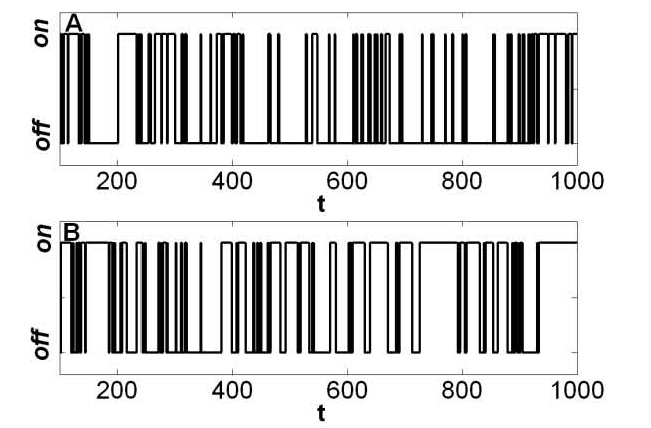Two-state trajectory on:
[Wikipedia]
[Google]
[Amazon]
 A two-state trajectory (also termed two-state time trajectory or a trajectory with two states) is a dynamical signal that fluctuates between two distinct values: ON and OFF, open and closed, , etc. Mathematically, the signal has, for every either the value or .
In most applications, the signal is
A two-state trajectory (also termed two-state time trajectory or a trajectory with two states) is a dynamical signal that fluctuates between two distinct values: ON and OFF, open and closed, , etc. Mathematically, the signal has, for every either the value or .
In most applications, the signal is
 A two-state trajectory (also termed two-state time trajectory or a trajectory with two states) is a dynamical signal that fluctuates between two distinct values: ON and OFF, open and closed, , etc. Mathematically, the signal has, for every either the value or .
In most applications, the signal is
A two-state trajectory (also termed two-state time trajectory or a trajectory with two states) is a dynamical signal that fluctuates between two distinct values: ON and OFF, open and closed, , etc. Mathematically, the signal has, for every either the value or .
In most applications, the signal is stochastic
Stochastic (, ) refers to the property of being well described by a random probability distribution. Although stochasticity and randomness are distinct in that the former refers to a modeling approach and the latter refers to phenomena themselv ...
; nevertheless, it can have deterministic
Determinism is a philosophical view, where all events are determined completely by previously existing causes. Deterministic theories throughout the history of philosophy have developed from diverse and sometimes overlapping motives and consi ...
ON-OFF components. A completely deterministic two-state trajectory is a square wave
A square wave is a non-sinusoidal periodic waveform in which the amplitude alternates at a steady frequency between fixed minimum and maximum values, with the same duration at minimum and maximum. In an ideal square wave, the transitions b ...
. There are many ways one can create a two-state signal, e.g. flipping a coin repeatedly.
A stochastic two-state trajectory is among the simplest stochastic processes. Extensions include: three-state trajectories, higher discrete state trajectories, and continuous trajectories in any dimension.
Two state trajectories in biophysics, and related fields
Two state trajectories are very common. Here, we focus on relevant trajectories in scientific experiments: these are seen in measurements in chemistry, physics, and the biophysics of individual molecules (e.g. measurements of protein dynamics and DNA and RNA dynamics, activity ofion channel
Ion channels are pore-forming membrane proteins that allow ions to pass through the channel pore. Their functions include establishing a resting membrane potential, shaping action potentials and other electrical signals by gating the flow of io ...
s, enzyme activity, quantum dot
Quantum dots (QDs) are semiconductor particles a few nanometres in size, having light, optical and electronics, electronic properties that differ from those of larger particles as a result of quantum mechanics. They are a central topic in nanote ...
s). From these experiments, one aims at finding the correct model explaining the measured process. We explain about various relevant systems in what follows.
Ion channels
Since theion channel
Ion channels are pore-forming membrane proteins that allow ions to pass through the channel pore. Their functions include establishing a resting membrane potential, shaping action potentials and other electrical signals by gating the flow of io ...
is either opened or closed, when recording the number of ions that go through the channel when time elapses, observed is a two-state trajectory of the current versus time.
Enzymes
Here, there are several possible experiments on the activity of individualenzymes
Enzymes () are proteins that act as biological catalysts by accelerating chemical reactions. The molecules upon which enzymes may act are called substrate (chemistry), substrates, and the enzyme converts the substrates into different molecule ...
with a two-state signal. For example, one can create substrate that only upon the enzymatic activity shines light when activated (with a laser pulse). So, each time the enzyme acts, we see a burst of photons during the time period that the product molecule is in the laser area.
Dynamics of biological molecules
Structural changes of molecules are viewed in various experiments' type. Förster resonance energy transfer is an example. In many cases one sees a time trajectory that fluctuates among several cleared defined states.Quantum dots
Another system that fluctuates among an on state and an off state is aquantum dot
Quantum dots (QDs) are semiconductor particles a few nanometres in size, having light, optical and electronics, electronic properties that differ from those of larger particles as a result of quantum mechanics. They are a central topic in nanote ...
. Here, the fluctuations are since the molecule is either in a state that emits photons or in a dark state that does not emit photons (the dynamics among the states are influenced also from its interactions with the surroundings).
See also
* Single-molecule experiment *Reduced dimensions form
In biophysics and related fields, reduced dimension forms (RDFs) are unique on-off mechanisms for random walks that generate two-state trajectories (see Fig. 1 for an example of a RDF and Fig. 2 for an example of a two-state trajectory). It has b ...
* Kinetic scheme
In physics, chemistry and related fields, a kinetic scheme is a network of states and connections between them representing the scheme of a dynamical process. Usually a kinetic scheme represents a Markovian process, while for non-Markovian process ...
* Master equation
* Wave
References
{{reflist Statistical mechanics Stochastic processes